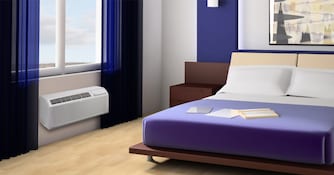
5 Ways To Keep Your Cool This Summer
Air conditioning technology has come a long way over the years, and now there are more options than ever before.
Separating the various styles, understanding their strengths and weaknesses, and defining their intended applications will help you narrow your search and find what will work best for you.
Efficiency, comfort, and installation requirements are all important factors to consider; so before you begin shopping systems and consulting HVAC technicians, let's take a look at the following systems:
- Central Air Conditioners
- Mini Splits
- Window A/C Units
- Portable A/C Units
- PTACs (Packaged Terminal Air Conditioners)
Central Air Conditioners
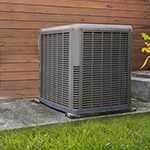 Central air conditioners are undoubtedly the most common style of air conditioning found in single-family homes. You can easily recognize a home with central air conditioning by the large box-shaped outdoor condenser, but they also utilize an indoor coil and a blower.
Central air conditioners are undoubtedly the most common style of air conditioning found in single-family homes. You can easily recognize a home with central air conditioning by the large box-shaped outdoor condenser, but they also utilize an indoor coil and a blower.
The biggest factor to keep in mind with central air conditioning systems is that they require duct work. Ducts carry the cool air from the blower to distribute it to each room in your home. If your home doesn't already feature ducts, you may not enjoy the amount of labor and cost that goes into installing it.
Some older homes present serious challenges to installing ductwork. In some cases, it may not be possible. To avoid the complications, cost, and labor of installing air ducts, consider a ductless mini split system.
Mini Split Systems
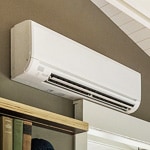 Mini split systems are similar to what you'd expect from central air, but they require no duct work, and they're much more efficient. Instead of ducts, mini splits feature individual indoor head units in each area you're conditioning.
Mini split systems are similar to what you'd expect from central air, but they require no duct work, and they're much more efficient. Instead of ducts, mini splits feature individual indoor head units in each area you're conditioning.
Mini split systems carry refrigerant through small tubes from the outdoor compressor to the indoor units. The tubes can be fed through a small 3-inch hole into your home, so there's much less installation involved than with duct work.
Mini splits enable you to condition specific zones, meaning you don't have to cool all of the rooms in your home if you're only using two. This provides better efficiency, saves you on utility costs, and even enables you to set custom temperatures for each zone.
With a ductless mini split system, you can set the family room to 72 degrees while maintaining a cool, comfortable 67 degrees in your bedroom when sleeping. You can also install a mini split unit in your garage or workshop area. When you're using the area, you turn it on; and when you're not, you can turn it off to save energy.
Mini splits are also an effective way to condition one or two rooms that are under-served by your current air conditioning system. If you have central air, but have since built on an addition to your home, you may not want to install new duct work to condition that new part of your home. A mini split system can be added to heat and cool your new living space.
Window Air Conditioning Units
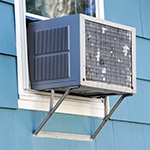 You've most likely seen a window air conditioner before. These units are placed in an open window with no screen, and are held in place by the window itself. They typically come with louvers to close the gaps on either side of the unit, as the window will generally be wider.
You've most likely seen a window air conditioner before. These units are placed in an open window with no screen, and are held in place by the window itself. They typically come with louvers to close the gaps on either side of the unit, as the window will generally be wider.
In the winter, these units should be removed so that the window can be closed off. However, people often tend to cover the outside of the unit with a plastic garbage bag and tape plastic wrapping or cardboard over the gaps to seal the cold out. A more permanent solution would be to get a through-the-wall air conditioning unit.
Although less efficient and quiet than mini split and central air conditioning systems, window a/c units are an affordable and convenient solution. They are also relatively simple to install and can be easily removed, making them a good choice for seasonal usage.
Portable Air Conditioning Units
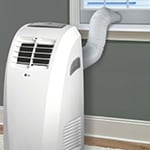 Like window units, portable air conditioning units also contain the condenser, coil, and blower all within the same unit. Because of this compact design, they're the least efficient of all the air conditioning systems.
Like window units, portable air conditioning units also contain the condenser, coil, and blower all within the same unit. Because of this compact design, they're the least efficient of all the air conditioning systems.
While there are some units with air intake hoses, most have one hose to eject hot air out through a window. Because most portable air conditioners don't have a fresh air intake hose, they're only ejecting air. This creates a vacuum, which forces air to seep into the home from outside in order to make its way to the unit.
Even though the lack of a fresh air intake contributes to lower efficiency, there are now more efficient portable a/c units that feature a dual hose design to address this issue.
Portable air conditioners are by far the easiest and quickest ways to get personalized comfort. Installation is a breeze and the portability allows you to move the a/c unit to another room, if needed.
Portable a/c units are perfect for anyone who is looking to cool down quickly in applications that aren't conducive to permanent solutions like dorm rooms, high rise buildings, mobile homes, attics, etc.
Packaged Terminal Air Conditioners
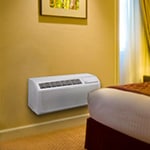 Packaged terminal air conditioners, often called PTACs, are similar to a window air conditioner, but they don't install in a window and require a lot more installation work.
Packaged terminal air conditioners, often called PTACs, are similar to a window air conditioner, but they don't install in a window and require a lot more installation work.
PTAC units are a permanent solution installed through your exterior wall. This means you must cut a very large hole through your studs, drywall, and siding.
Often times, especially in residential applications, this installation will require framing work to maintain structural integrity. While they don't block a window, they're still rather noisy, less efficient than mini split or central air systems, and are not ideal for conditioning your entire home.
Packaged terminal air conditioners are typically found in hotels, nursing home facilities, some high rise apartments, and the occasional hospital room. They're not typically found in single-family homes or apartments, as their installation requirements outweigh their efficiency and effectiveness in those applications.




